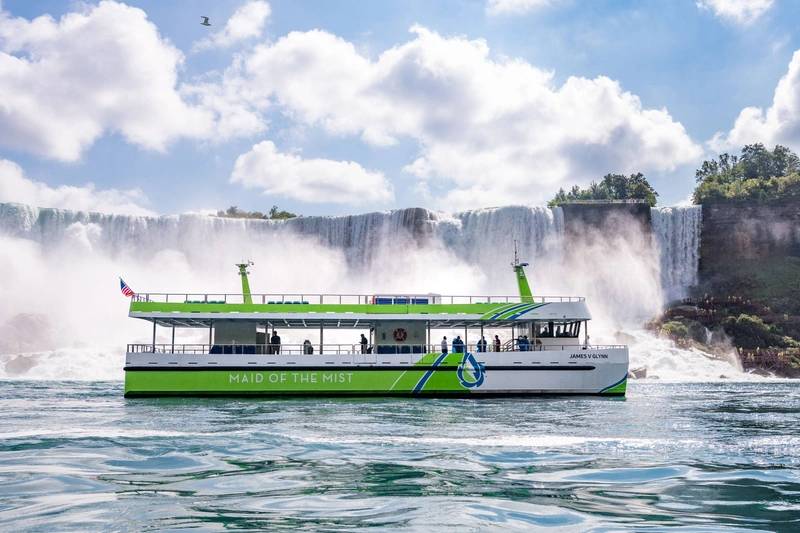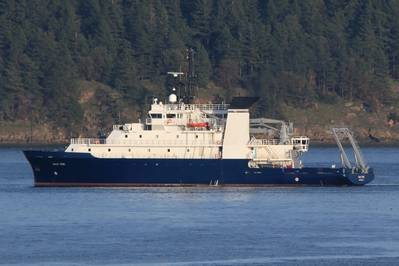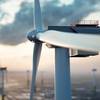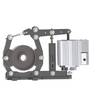Greening the U.S. Federal Fleet
The international shipping industry as a whole is responsible for 2% to 3% of global greenhouse gas emissions, and if nothing changes, those will increase by 250% by 2050, according to the International Maritime Organization (IMO). Sobering numbers like these have made reducing emissions across the sector a focus for governments, shipbuilders, environmentalists, vessel owners and technology suppliers alike.
The United States federal ship fleet, excluding combat ships, consists of various types of vessels utilized for civilian purposes. This fleet of vessels makes the U.S. government one of the largest vessel owners or leasers of vessels in the world. These ships play crucial roles in various sectors, including transportation, research, commerce and public services.
Government's role
The federal government's role in promoting sustainability and combating climate change is crucial. One powerful tool at its disposal is its buying power, which can be leveraged to invest in new green technologies. Such investments carry significant importance for several compelling reasons.
First, investing in green technologies through its procurement authority enables the federal government to lead by example. By adopting renewable energy sources, energy-efficient systems and sustainable practices, the government demonstrates its commitment to environmental sustainability. This sends a strong message to the commercial and local government maritime industry, encouraging them to follow suit and contribute to the collective effort in combating climate change.
Second, these investments foster economic growth and job creation. U.S. government acquisitions can prioritize U.S. content, and this would help develop the manufacturing of new technology in the U.S. Currently Europe and Scandinavia dominate in the manufacturing of marine focused equipment, but the U.S. can change this trend with large investments. Additionally, it would allow U.S. shipyards to rely on a steady order flow of new technology vessels enabling them to hire skilled workers and develop new supply chains to drive down costs.
Furthermore, utilizing buying power to invest in new technologies enhances U.S. energy independence. By prioritizing renewable energy sources, the federal government reduces the nation's reliance on fossil fuels and imported energy. This increases energy security, decreases vulnerability to fuel price fluctuations, and strengthens the stability of the energy market.
Emissions reduction is not the only benefit to owners investing in electric propulsion technology. One additional benefit comes in the potentially lower cycle costs allowing the government to save money. Once purchased, these vessels have a decades-long operational life allowing for initially higher capital expenses to be more than recovered in operational expense savings. Most alternative propulsion system arrangements are centered around an electrified powertrain. Whether diesel, full battery power or fuel cell power, most low- and zero-emissions vessels will employ an electrified powertrain as it allows for easy integration of current and future power sources. This is important for Jones Act vessels that often undergo multiple repowers over their sometimes 50+ year lives.
An added benefit will be developing a workforce with the skills necessary to propel the industry. Like many other industries, the maritime sector finds itself in need of new skills due to a lack of experience among shipbuilders and asset owners with the technologies like energy storage and DC power distribution. This will be as important as engineering challenges with all-electric and hybrid ships for the industry to address if the promise of a green fleet is to be realized. As the largest employer of both civilian and government sailors, the federal fleet is where most sailors learn their skills. It would be a great benefit to the industry to have a pipeline of skilled electrical and automation engineers with shipboard expertise as they transition from government to commercial vessels.
Lastly, by prioritizing green technology investments, the federal government positions itself as a global leader in sustainability. It sets an example for other nations and encourages international cooperation in addressing climate change. By taking the lead in adopting and supporting green technologies, the government enhances its diplomatic relations, influences global policy discussions and fosters a collaborative approach to solving environmental challenges.
The federal government's use of its buying power to invest in new green technologies is of paramount importance. Such investments drive environmental sustainability, foster economic growth, promote public health, drive technological innovation and position the nation as a global leader in addressing climate change. By prioritizing green technology investments, the federal government takes proactive steps towards creating a more sustainable and resilient future for all.
Lessons from early adopters
The federal government's investment in new green technologies drives technological innovation. As these technologies are relatively new to maritime applications, there is risk and effort before they eventually become commonly utilized. Currently the burden of new low- and zero-emission vessels falls on commercial and local governments.
An example of the possibilities with zero emission operations is the iconic ferry Maid of the Mist, the first all battery-electric boat in the U.S., which has been operating now for three years with minimal downtime. One of the major hurdles in switching to electric propulsion is the associated changes in operating practices.
Maid of the Mist's Executive Vice President John Sicinski said, "End users have all new considerations. You have few moving parts, but software and electronics have different diagnostic paths than mechanical systems. It's more of an IT thing, which also leads to different personnel needs."
"The big drivers are regulation and funding," Sicinski said. "It's scary being first, and there are a lot of people on the fence."
 The government can benefit from lessons learned in commercial green vessel operations. Maid of the Mist's all battery-electric boats—the first of their kind in the U.S—have been operating for three years at Niagara Falls. (Photo: ABB)
The government can benefit from lessons learned in commercial green vessel operations. Maid of the Mist's all battery-electric boats—the first of their kind in the U.S—have been operating for three years at Niagara Falls. (Photo: ABB)
The Coast Guard's Marine Safety Center (MSC) is faced with the challenge of ensuring the safety of vessels, regardless of propulsion technology. As lithium-ion batteries, fuel cells, hydrogen and other new technologies become commercially available, the MSC is tasked with updating the Code of Federal Regulations (CFR) to address these new technologies. This will require time and resources. If significant investments can be made to utilize new technology on the federal fleet this would help accelerate these updates to the CFRs in turn benefiting commercial owners.
Electric propulsion is generally understood to mean batteries or an onboard generator providing power to an electric motor that in turn moves the propeller, or alternatively, a combustion engine running on "green" fuel such as ammonia, methanol or renewable diesel produced using renewable energy (solar, wind, hydro, nuclear). Which approach will win?
"It won't necessarily be the best fuel from an engineering standpoint," said Morgan Fanberg, CEO of naval architecture and marine engineering firm Glosten. "It will be the one that is the most readily available the most marketable," he explained, citing the example of VHS winning out over Betamax in home video despite the latter having distinct technological advantages.
For the marine industry, alternative liquid fuels like ammonia, methanol and renewable diesel would need to be produced and stored in such vast quantities, it probably isn't realistic to expect they will displace all usage of conventional fossil fuels—at least not for all applications, or soon.
"Congress is aware this isn't going to happen on its own," Fanberg said. "Vessel operators are looking for ways to remain profitable while complying with regulations, and that's going to be very difficult."
Fanberg said the best way to move forward is with federal grants for commercial and small municipal operators to jump start their green journey, whether that means electric, hybrid, or alternative fuels. The Inflation Reduction Act does that with millions allocated to marine sector and has allowed some ferry owners make the transition to low- or zero-emission vessels.
As vessels like ferries electrify, electric utilities are faced with high power loads during recharge. This can often trigger demand charges which can significantly challenge the otherwise favorable economics to move to electric. Solutions like shoreside energy storage systems are available to mitigate this, though they can add cost and complexity to the project. The U.S. government has invested in shoreside power through funding mechanisms like the Port Infrastructure Development Grants.
Here are some examples of non-combat ship categories in the U.S. federal fleet:
Research vessels: These ships are used for scientific exploration, oceanographic research and environmental studies. They facilitate important research activities such as studying marine ecosystems, climate patterns and geological surveys.
Cargo ships: These vessels transport goods and commodities across domestic and international waters. They contribute to the nation's ability to support U.S. interests overseas.
Passenger vessels: These ships are primarily designed for transporting people and are used for various purposes such as ferrying passengers within the National Parks Services. The public loves to visit some of the U.S.'s most treasured areas and it can be done without emissions. Building on the already established vehicle charging in the NPS the addition of electric charging for passenger vessels would have a major impact.
Coast Guard vessels: Although the Coast Guard primarily focuses on enforcing maritime laws and conducting search and rescue operations, they also operate non-combat ships. These include icebreakers, buoy tenders, and other vessels involved in maintaining navigational aids, maritime safety and environmental protection.
Support Vessels: The federal fleet includes support ships that assist in a range of activities such as supplying and refueling other ships, tugs, towboats, dredging and transporting equipment and personnel, and conducting maintenance and repair work.
Training Ships: These vessels are utilized for training purposes, especially in maritime academies and naval programs. They provide hands-on experience and practical training to aspiring sailors, officers and maritime professionals.
The U.S. federal ship fleet is diverse, serving numerous functions essential to the nation's maritime operations, economic activities and research endeavors. There are many opportunities within this fleet to help blaze a path toward a more sustainable future for the maritime industry.














